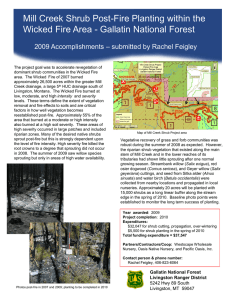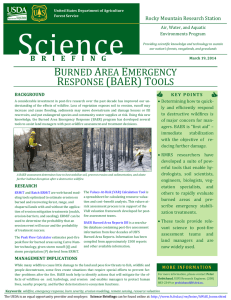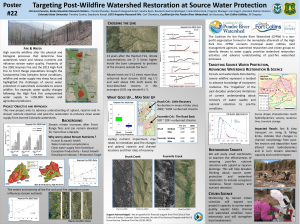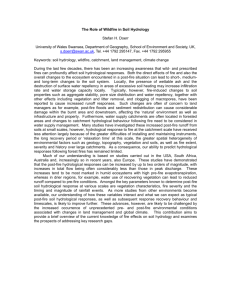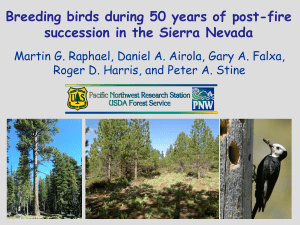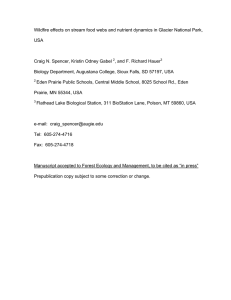Postfire Community Structure of Birds and Rodents in Southern California Chaparral 1
advertisement
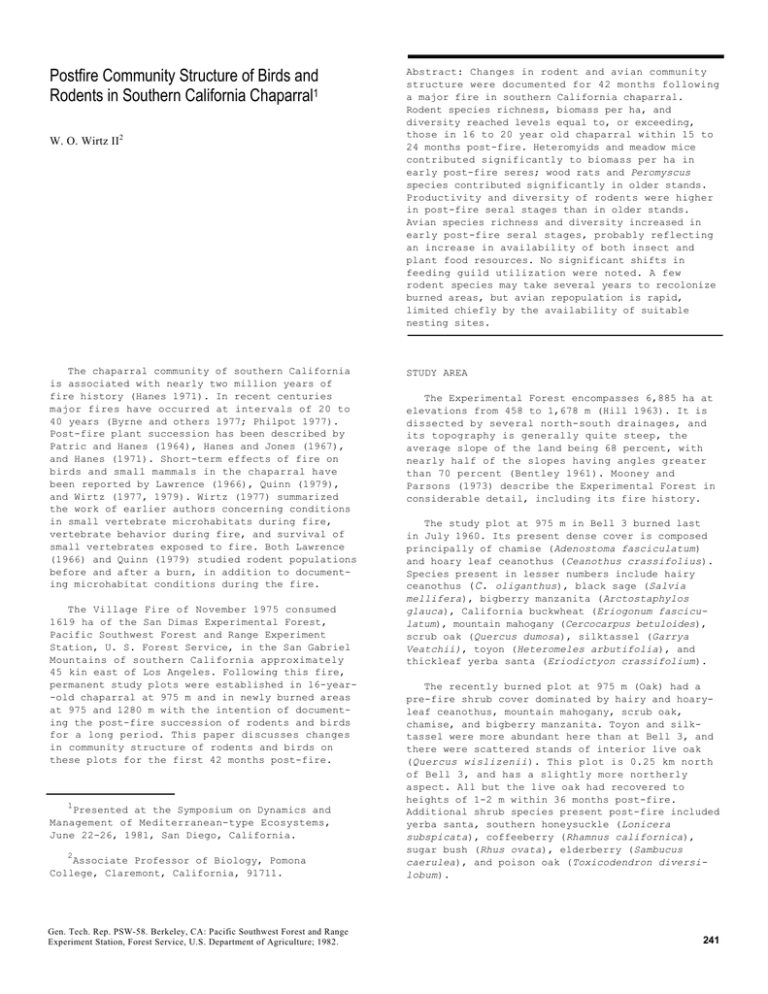
Postfire Community Structure of Birds and Rodents in Southern California Chaparral1 W. O. Wirtz II2 The chaparral community of southern California is associated with nearly two million years of fire history (Hanes 1971). In recent centuries major fires have occurred at intervals of 20 to 40 years (Byrne and others 1977; Philpot 1977). Post-fire plant succession has been described by Patric and Hanes (1964), Hanes and Jones (1967), and Hanes (1971). Short-term effects of fire on birds and small mammals in the chaparral have been reported by Lawrence (1966), Quinn (1979), and Wirtz (1977, 1979). Wirtz (1977) summarized the work of earlier authors concerning conditions in small vertebrate microhabitats during fire, vertebrate behavior during fire, and survival of small vertebrates exposed to fire. Both Lawrence (1966) and Quinn (1979) studied rodent populations before and after a burn, in addition to documenting microhabitat conditions during the fire. The Village Fire of November 1975 consumed 1619 ha of the San Dimas Experimental Forest, Pacific Southwest Forest and Range Experiment Station, U. S. Forest Service, in the San Gabriel Mountains of southern California approximately 45 kin east of Los Angeles. Following this fire, permanent study plots were established in 16-year-old chaparral at 975 m and in newly burned areas at 975 and 1280 m with the intention of documenting the post-fire succession of rodents and birds for a long period. This paper discusses changes in community structure of rodents and birds on these plots for the first 42 months post-fire. 1 Presented at the Symposium on Dynamics and Management of Mediterranean-type Ecosystems, June 22-26, 1981, San Diego, California. 2 Associate Professor of Biology, Pomona College, Claremont, California, 91711. Gen. Tech. Rep. PSW-58. Berkeley, CA: Pacific Southwest Forest and Range Experiment Station, Forest Service, U.S. Department of Agriculture; 1982. Abstract: Changes in rodent and avian community structure were documented for 42 months following a major fire in southern California chaparral. Rodent species richness, biomass per ha, and diversity reached levels equal to, or exceeding, those in 16 to 20 year old chaparral within 15 to 24 months post-fire. Heteromyids and meadow mice contributed significantly to biomass per ha in early post-fire seres; wood rats and Peromyscus species contributed significantly in older stands. Productivity and diversity of rodents were higher in post-fire seral stages than in older stands. Avian species richness and diversity increased in early post-fire seral stages, probably reflecting an increase in availability of both insect and plant food resources. No significant shifts in feeding guild utilization were noted. A few rodent species may take several years to recolonize burned areas, but avian repopulation is rapid, limited chiefly by the availability of suitable nesting sites. STUDY AREA The Experimental Forest encompasses 6,885 ha at elevations from 458 to 1,678 m (Hill 1963). It is dissected by several north-south drainages, and its topography is generally quite steep, the average slope of the land being 68 percent, with nearly half of the slopes having angles greater than 70 percent (Bentley 1961). Mooney and Parsons (1973) describe the Experimental Forest in considerable detail, including its fire history. The study plot at 975 m in Bell 3 burned last in July 1960. Its present dense cover is composed principally of chamise (Adenostoma fasciculatum) and hoary leaf ceanothus (Ceanothus crassifolius). Species present in lesser numbers include hairy ceanothus (C. oliganthus), black sage (Salvia mellifera), bigberry manzanita (Arctostaphylos glauca), California buckwheat (Eriogonum fasciculatum), mountain mahogany (Cercocarpus betuloides), scrub oak (Quercus dumosa), silktassel (Garrya Veatchii), toyon (Heteromeles arbutifolia), and thickleaf yerba santa (Eriodictyon crassifolium). The recently burned plot at 975 m (Oak) had a pre-fire shrub cover dominated by hairy and hoaryleaf ceanothus, mountain mahogany, scrub oak, chamise, and bigberry manzanita. Toyon and silktassel were more abundant here than at Bell 3, and there were scattered stands of interior live oak ( Quercus wislizenii ). This plot is 0.25 km north of Bell 3, and has a slightly more northerly aspect. All but the live oak had recovered to heights of 1-2 m within 36 months post-fire. Additional shrub species present post-fire included yerba santa, southern honeysuckle (Lonicera subspicata), coffeeberry (Rhamnus californica), sugar bush (Rhus ovata), elderberry (Sambucus caerulea), and poison oak (Toxicodendron diversilobum). 241 The burned plot at 1280 m (Sunset) had a prefire shrub cover dominated by deerbrush (Ceanothus integerrimus), chaparral whitethorn (C. leucodermis ), hoaryleaf ceanothus, chamise, scrub oak, and bigberry manzanita. This area has experienced a post-fire succession quite different from Oak, presumably due to its higher elevation. The area was dominated by low herbs and grasses (chiefly Cryptantha intermedia, Stephanomeria virgata, Chaenactis artemisaefolia, Eschscholzia californica, Penstemon spectabilis, Sisymbrium altissimum, Emmenanthe pendulifera, Chichorium intybus, Bromus tectorum) and a shrubby lupine (Lupinus excubitus ) in 1976, the first spring post-fire. By 1977 the lupine was extremely abundant (frequency - 92 percent), herbs were decreasing in relative abundance, and shrub species were resprouting vigorously. By spring 1978 the area had regained its shrubby nature, with ceanothus, chamise, scrub oak, bigberry manzanita, and thickleaf yerba santa being the most common species. METHODS Square grids of 100 stations at 15 m intervals were established on each of the three study areas. Large Sherman traps were used in a mark and release study to obtain information on rodent populations. Determination of mean distance traveled between captures permitted estimation of the actual area sampled per species per plot. Population density was estimated for each trapping period by the Hayne (1949) equation, and animals per ha determined per species. Mean weights were calculated separately for each species, plot, and trapping period. These values were used with density estimates to determine gm per ha for each species and trapping period. Percent of total biomass per ha per species is used in this paper. Brillouin (1956) diversity indices were calculated for each trapping period and plot. Birds were censused for each trapping period and on some occasions when trapping was not conducted. Both sightings and sounds were noted as the observer walked the entire grid; individuals overhead were also noted. These observations were converted to individuals per species per man-hour and also to percent of total sightings per species per month, providing indices of relative abundance rather than actual density estimates. Brillouin diversity indices were calculated for each area and sampling period. Wirtz (1979 and in press) divided the avifauna of the San Gabriel Mountain chaparral community into 13 feeding categories or guilds, based on field observations and data in Martin and others (1951). The percentage of species observed per area per period in common feeding guilds was calculated to ascertain whether shifts in food availability occurred during postfire succession. RESULTS Rodents The rodent fauna of this chaparral community consists of 11 species in 8 genera representing 3 families. The Beechey ground squirrel (Spermophilus beecheyi) and Merriam chipmunk (Eutamias merriami), family Sciuridae, are seldom seen or trapped. The California pocket mouse (Perognathus californicus) and Pacific kangaroo rat (Dipodomys agilis) represent the family Heteromyidae. The remaining species are in the family Cricetidae, including the western harvest mouse (Reithrodontomys megalotis), California mouse (Peromyscus californicus), deer mouse (P. maniculatus), brush mouse (P. boylii), dusky-footed wood rat (Neotoma fuscipes), desert wood rat (N. lepida), and California meadow mouse (Microtus californicus). Total rodent biomass varied considerably on the unburned site, from a low of 333 gm/ha in September 1976 to highs of 1896 and 1547 gm/ha in December 1976 and May 1979, respectively (fig. 1). Total biomass was low on both burned plots for 12 months post-fire, increased rapidly from 15 to 30 months post-fire, and by 34 months post-fire had exceeded the maxima on the unburned plot (fig. 1). Seasonal fluctuations in total biomass did not occur on either burned or unburned plots. Wood rats (N. fuscipes and N. lepida) contributed 40 to 90 percent of total biomass per ha on the unburned plot (fig. 2). The contribution of both Pacific kangaroo rats and California pocket mice declined from 16 to 20 years post-fire, while that of brush and California mice combined increased (fig. 2). Only Pacific kangaroo rats, California pocket mice, and Peromyscus (maniculatus, californicus, and boylii ) were present on the burned plot at 975 m for 20 months post-fire (fig. 3). Kangaroo rats contributed a major portion of the biomass per ha for 25 months post-fire, but declined to Figure 1: Total rodent biomass, gm/ha, for burned and unburned plots. 242 Figure 2: Percent total biomass per ha for rodent genera on the unburned plot at 975 m. Figure 4: Percent total biomass per ha for rodent genera on the burned plot at 1280 m. burned plots than on the unburned plot since 30 months post-fire (fig. 5). There was little difference in diversity between unburned and burned plots at 975 m for 28 months post-fire (fig. 5). Diversity on the higher elevation burned plot was lower than that of lower elevation unburned and burned plots for 32 months post-fire, and both burned plots were more diverse than the unburned area from 32 to 42 months post-fire. Birds Figure 3: Percent total biomass per ha for rodent genera on the burned plot at 975 m. contribute less than 10 percent by 42 months postfire. Wood rats (both N. fuscipes and N. lepida) and California meadow mice first appeared on this plot at 20 months post-fire, and contributed 25 to 50 percent of biomass per ha between 30 and 42 months post-fire (fig. 3). California pocket mouse populations declined on the plot from 20 to 42 months, and Peromyscus populations remained low throughout the entire period (fig. 3). A total of 73 diurnal bird species were observed on the three study plots during the period, but only 23 species occurred regularly (see Wirtz 1979 and in press for a detailed description of the avifauna of the chaparral of the San Gabriel Mountains). Common feeding guilds represented were raptors (7 species), omnivores (2 species), nectar-feeders (5 species), seed-eaters (6 species), insect and fruit eaters (9 species), insect and seed eaters (13 species), those gleaning insects from vegetation (14 species), and those taking insects from the air (8 species). Pacific kangaroo rats contributed 40 to 95 percent of biomass per ha on the burned plot at 1280 m throughout the entire period (fig. 4). Wood rats (both N. fuscipes and N. lepida) were present on the plot by 10 months post-fire, and contributed 15 to 40 percent of biomass per ha from 15 to 41 months post-fire (fig. 4). California pocket mice and Peromyscus ( maniculatus and californicus) contributed 2 to 22 percent biomass per ha. between 10 and 41 months post-fire, and California meadow mice were present in very low numbers from 33 to 41 months post-fire (fig. 4). The number of rodent species has been highest on the burned plot at 975 m since 17 months postfire, and more species have been present on both Figure 5: Number of rodent species present (upper) and Brillouin diversity indices (lower), for burned and unburned plots. 243 The unburned plot at 975 m had the greatest number of species in the spring of 1976, 5 to 6 months post-fire, but by summer more species were present on the burned plot at 1280 m (fig. 6). More species were also present on the unburned plot in spring 1977, 17 to 18 months post-fire, but both burned plots had more species than the unburned plot in spring 1978 and 1979, 29 to 30 and 41 to 42 months post-fire, respectively, with the higher elevation burned plot having more species in both of these years (fig. 6). Omnivorous species were more prevalent on the higher elevation burned plot than on the unburned plot in spring 1976, more prevalent on the unburned site than on either burned site in fall and winter 1976-77 and again in winter 1978, but there was little difference in occurrence of omnivores during the rest of the period studied (fig. 7A). More seed-eating species were normally found on burned areas than on the unburned site; the greatest difference was in the first year postfire, and there was more fluctuation in the presence of seed-eating species at the higher elevation burned site (fig. 7B). Insect-and fruit-eating species fluctuated in their presence on burned sites, and did not equal or exceed numbers on the unburned site until the fourth year post-fire (fig. 7C). Insect and seed-eating species were much more prevalent on burned sites in the first year post-fire; subsequent occurrence varied but was similar to that on the unburned site (fig. 7D). Those species gleaning insects from vegetation were not common on the higher elevation burned site in the first year post-fire; burned an unburned areas did not show significant differences in occurrence during the next three years (fig. 7E). Species taking insects from the air, or on the wing, such as flycatchers, were less common, and more erratic in occurrence, at all sites (fig. 7F). There are no striking differences between burned and unburned sites. Brillouin diversity indices for avian occurrence on unburned and burned plots indicate greater diversity on burned plots (fig. 8). This difference is more pronounced for the first two years post-fire, and less for the latter two. Figure 6: Number of bird species present on burned and unburned plots. 244 Figure 7: Presence of different feeding guilds on burned and unburned plots, as percent of total species present: A) omnivores, B) seed eaters, C) insect and fruit eaters, D) insect and seed eaters, E) gleaners of insects from vegetation, F) insects taken from air. Wood rats, because of their large size, contribute significantly to biomass per ha in older chaparral stands (fig. 2). Their contribution on burned areas increases slowly between 2 and 3 years post-fire (figs. 3 and 4). Peromyscus abundance and biomass contribution increases as stands age from 16 to 20 years (fig. 2). Figure 8: Brillouin diversity indices for avian populations on burned and unburned plots. DISCUSSION Only 6 rodent species are commonly found in older chaparral stands in the San Gabriel Mountains: California pocket mouse, Pacific kangaroo rat, California mouse, brush mouse, dusky-footed wood rat, and desert wood rat. Western harvest mouse, deer mouse, and California meadow mouse inhabit disturbed habitats in this region, whether they be grassland conversions (Wirtz 1977) or post-fire seral stages. The burrowing habit enhances rodents' ability to survive fire (Howard and others 1959; Lawrence 1966; Quinn 1979). Thus, post-fire rodent communities in this region are dominated by kangaroo rats (figs. 3 and 4; Quinn 1979) and, to a lesser extent, pocket mice. Rapid post-fire plant succession reduces habitat suitability for burrowing heteromyids, and their abundance and contribution to total biomass declines (figs. 3 and 4). Pacific kangaroo rats exhibit a significant preference for open space in their habitat, most likely associated with their saltatorial mode of locomotion. Utilization of above-ground stick nests by wood rats makes them particularly susceptible to fire (Horton and Wright 1944; Quinn 1979), and they may not successfully recolonize burned areas until 1-2 years post-fire (figs. 3 and 4). Deer mice and California meadow mice colonize burned areas within 1-2 years post-fire (figs. 3 and 4). Though rodent communities may be decimated by wildfire, recolonization and subsequent reproduction bring species numbers, biomass per ha, and diversity to levels equal to, or exceeding, those in 16 to 20 year old chaparral within 15 to 24 months post-fire (figs. 1 and 5). Productivity and diversity of rodents is higher in post-fire seral stages than in older stands, and data collected in this study suggest that both begin to decline when the stand reaches 18 to 20 years of age (figs. 2 and 5). Both bird species richness and species diversity increased during 42 months post-fire (figs. 6 and 8). The increase in richness most likely reflects the addition of rare species with more observer time on the study plots, as the phenomenon occurred on unburned as well as burned plots. An increased number of species present on the higher elevation burned plot in the first spring post-fire may reflect increased richness in both insect and plant food resources associated with the great plant species richness that occurred in that spring. Lawrence (1966) reports increased diversity of bird species following a controlled burn in the chaparral of Sierra Nevada foothills, and Bock and Lynch (1970) report increased richness and diversity on burned plots in Sierra Nevada coniferous forest. Higher diversity indices for burned plots in all springs post-fire (fig. 8) reflect changes in population size of species already present rather than addition of species. No increase was noted in the number of omnivorous species present on burned areas (fig. 7A), but increases were noted in the number of seed-eating (fig. 7B) and insect-and seed-eating (fig. 7D) species. These differences are most pronounced in the first year post-fire. Insect-and fruitfeeding species exhibit an initial decrease in use of burned areas (fig. 7C), presumably because fruits are not available. Species that glean insects from vegetation also exhibit an initial decrease in utilization of burned areas (fig. 7E), presumably due to lack of vegetation, while species that take insects from the air exhibit little response to fire (fig. 7F). No significant shifts in feeding guild utilization of burned habitats is noted, and therefore it is assumed that shifts also do not occur in food type availability in burned habitats. Rodent populations are initially decimated by wildfire. Only burrowing forms survive in any numbers. Post-fire recovery is rapid, however, with biomass per ha exceeding that in 16 to 20 year old chaparral within two years. Species lost in the fire, like wood rats, may not return to the site for two years. It is assumed that some refugia always remain for these species, due to the normally patchy nature of burns. Species that thrive in disturbed areas, like the deer mouse (Williams 1955), or herbivorous forms like the California meadow mouse, colonize early post-fire seral stages. Brush-tolerant species, such as wood rats and California and brush mice, assume a greater role in the community as it returns to shrub seral stages. By 20 years post-fire early 245 successional forms like deer mouse and meadow mouse have vanished, burrowing heteromyids have declined in abundance as the shrub canopy closes in and ground level open space is eliminated, and shrub-tolerant species like wood rats and brush and California mice predominate. Fire reduces both food availability and nesting cover for bird species. Post-fire plant and insect succession rapidly restores food availability. Avian species diversity is enhanced slightly in early post-fire seral stages due to food resource diversity. Numbers of individuals are greater on early post-fire seral stages, resulting in higher diversity indices. Rapid replacement of early herb and grass seral stages by shrub-dominated stages reduces this diversity within four years post-fire. Though individuals are lost in wildfires, few species are lost. Surviving individuals are able to repopulate quickly as plant succession occurs. A few rodent species may take several years to recolonize burned areas, but avian repopulation is rapid, perhaps limited chiefly by the availability of suitable nesting sites. ACKNOWLEDGMENTS The author is indebted to the Pacific Southwest Forest and Range Experiment Station, and to Pomona College, for financial support for this project, and to C. Eugene Conrad, Project Leader, San Dimas Experimental Forest, for his continual cooperation. Dr. Paulette Bierzychudek provided helpful criticism of the manuscript. Many present and former students have helped with field work, especially Sharon L. Booth, C. Eric Orr, John A. Lubina, and Joel S. Brown. All figures are by Helen J. Wirtz, who also frequently participated in field work. LITERATURE CITED Bentley, Jay R. Fitting brush conversion to San Gabriel watersheds. USDA Forest Service, Pacific Southwest Forest and Range Experiment Station, Berkeley, Calif., Misc. Paper 61; 1961; 1-8. Bock, Carl E.; Lynch, James F. Breeding bird populations of burned and unburned conifer forest in the Sierra Nevada. Condor 72(2):182189; 1970. Brillouin, Leon. Science and information theory. New York; Academic Press; 1956; 1-320. Byrne, Roger; Michaelsen, Joel; Soutar, Andrew. Fossil charcoal as a measure of wildfire frequency in southern California: A preliminary analysis. IN: Mooney, Harold A.; Conrad, C. Eugene, eds. Proc. symposium on the environmental consequences of fire and fuel management in Mediterranean ecosystems. USDA Forest Service, Gen. Tech. Report WO-3; 1977; 361-367. Hanes, Ted L. Succession after fire in the chaparral of southern California. Ecol. Mono. 41(1): 27-52; 1971. 246 Hanes, Ted L.; Jones, Harold W. Post-fire chaparral succession in southern California. Ecol. 48(2):259-264; 1967. Rayne, Don W. Two methods of estimating population from trapping records. J. Mamm. 30(4): 399-411; 1949. Hill, Lawrence W. The San Dimas Experimental Forest. USDA Forest Service, Pacific Southwest Forest and Range Experiment Station, Berkeley, Calif.; 1963; 1-24. Horton, John S.; Wright, Jerome T. The wood rat as an ecological factor in southern California watersheds. Ecol. 25(3):341-351; 1944. Howard, Walter E.; Fenner, R. L.; Childs, Henry E., Jr. Wildlife survival on brush burns. J. Range Mgmt. 12(5):230-234; 1959. Lawrence, George E. Ecology of vertebrate animals in relation to chaparral fire in the Sierra Nevada foothills. Ecol. 47(2):278-291; 1966. Martin, Alexander C.; Zim, Herbert S.; Nelson, Arnold L. American wildlife and plants: A guide to wildlife food habits. New York; Dover Publ.; 1961; 1-500. Mooney, Harold A.; Parsons, David J. Structure and function of the California chaparral - an example from San Dimas. IN: di Castri, Francesco; Mooney, Harold A., eds. Mediterranean type ecosystems. New York; Springer-Verlag; 1973; 83-112. Patric, James J.; Hanes, Ted L. Chaparral succession in a San Gabriel Mountain area in California. Ecol. 45(2):353-360; 1964. Philpot, Charles W. Vegetative features as determinants of fire frequency and intensity. IN: Mooney, Harold A.; Conrad, D. Eugene, eds. Proc. symposium on the environmental consequences of fire and fuel management in Mediterranean ecosystems. USDA Forest Service, Gen. Tech. Report WO-3; 1977; 12-16. Quinn, Ronald D. Effects of fire on small mammals in the chaparral. Cal-Neva Wildlife Transactions; 1979; 125-133. Williams, Olwen. Distribution of mice and shrews in a Colorado montane forest. J. Mamm. 36(2): 221-231; 1955. Wirtz, William O., II. Vertebrate post-fire succession. IN: Mooney, Harold A.; Conrad, C. Eugene, eds. Proc. symposium on the environmental consequences of fire and fuel management in Mediterranean ecosystems. USDA Forest Service, Gen. Tech. Report WO-3; 1977; 46-57. Wirtz, William O., II. Effects of fire on birds in chaparral. Cal-Neva Wildlife Transactions; 1979; 114-124. Wirtz, William O., II. Seasonal distribution, habitat utilization, and reproductive phenology of avifauna in southern California chaparral. Proceedings of the symposium on classification and distribution of California chaparral ecosystems, Pacific Southwest Forest and Range Experiment Station, Forest Serv., U.S. Dep. Agric., Berkeley, Calif.; in preparation.
